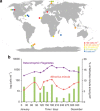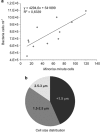Taming the smallest predators of the oceans
- PMID: 22810060
- PMCID: PMC3554395
- DOI: 10.1038/ismej.2012.85
Taming the smallest predators of the oceans
Abstract
Protists (unicellular eukaryotes) arguably account for most eukaryotic diversity and are central players of the biosphere. Known protist diversity and biology is largely based on cultured strains. Yet, environmental molecular surveys have unveiled entirely novel lineages that, as their prokaryotic counterparts, are essentially uncultured. Culture bias is an important drawback for any microbe-related science and is particularly severe for heterotrophic protists, which depend on organic food sources for growth. Here, we show how ecologically significant bacterivorous protists have been brought into culture by mimicking in situ conditions. Single cells sorted by serial dilution or flow cytometry were inoculated into seawater amended with natural bacterial assemblage at nearly in situ abundances. Strains belonging to lineages only known so far from environmental sequencing were isolated. Among them, Minorisa minuta gen. nov. sp. nov. forms a novel branch within Rhizaria, holding a key evolutionary position, and with an average size of 1.4 μm represents one of the smallest bacterial grazers known to date. It has a worldwide planktonic distribution and can account for 5% of heterotrophic protists communities in coastal waters. Physiological features of this strain can partly explain its success in the environment. Culturing ecologically relevant but elusive protists provide invaluable material for ecophysiology, genomics, ecosystem modeling and evolutionary issues.
Figures



Similar articles
-
Exploring the uncultured microeukaryote majority in the oceans: reevaluation of ribogroups within stramenopiles.ISME J. 2014 Apr;8(4):854-66. doi: 10.1038/ismej.2013.204. Epub 2013 Nov 7. ISME J. 2014. PMID: 24196325 Free PMC article.
-
Unveiling in situ interactions between marine protists and bacteria through single cell sequencing.ISME J. 2012 Mar;6(3):703-7. doi: 10.1038/ismej.2011.126. Epub 2011 Sep 22. ISME J. 2012. PMID: 21938022 Free PMC article.
-
Closely related protist strains have different grazing impacts on natural bacterial communities.Environ Microbiol. 2010 Dec;12(12):3105-13. doi: 10.1111/j.1462-2920.2010.02283.x. Environ Microbiol. 2010. PMID: 20602629
-
Unveiling new microbial eukaryotes in the surface ocean.Curr Opin Microbiol. 2008 Jun;11(3):213-8. doi: 10.1016/j.mib.2008.04.004. Epub 2008 Jun 13. Curr Opin Microbiol. 2008. PMID: 18556239 Review.
-
The molecular ecology of microbial eukaryotes unveils a hidden world.Trends Microbiol. 2002 Jan;10(1):31-8. doi: 10.1016/s0966-842x(01)02257-0. Trends Microbiol. 2002. PMID: 11755083 Review.
Cited by
-
Combining morphology, behaviour and genomics to understand the evolution and ecology of microbial eukaryotes.Philos Trans R Soc Lond B Biol Sci. 2019 Nov 25;374(1786):20190085. doi: 10.1098/rstb.2019.0085. Epub 2019 Oct 7. Philos Trans R Soc Lond B Biol Sci. 2019. PMID: 31587641 Free PMC article. Review.
-
Heterokont Predator Develorapax marinus gen. et sp. nov. - A Model of the Ochrophyte Ancestor.Front Microbiol. 2016 Aug 3;7:1194. doi: 10.3389/fmicb.2016.01194. eCollection 2016. Front Microbiol. 2016. PMID: 27536283 Free PMC article.
-
Exploring the uncultured microeukaryote majority in the oceans: reevaluation of ribogroups within stramenopiles.ISME J. 2014 Apr;8(4):854-66. doi: 10.1038/ismej.2013.204. Epub 2013 Nov 7. ISME J. 2014. PMID: 24196325 Free PMC article.
-
New avenues for potentially seeking microbial responses to climate change beneath Antarctic ice shelves.mSphere. 2024 May 29;9(5):e0007324. doi: 10.1128/msphere.00073-24. Epub 2024 Apr 26. mSphere. 2024. PMID: 38666797 Free PMC article.
-
Nucleomorph Genome Sequences of Two Chlorarachniophytes, Amorphochlora amoebiformis and Lotharella vacuolata.Genome Biol Evol. 2015 May 22;7(6):1533-45. doi: 10.1093/gbe/evv096. Genome Biol Evol. 2015. PMID: 26002880 Free PMC article.
References
-
- Arndt H, Dietrich D, Auer B, Cleven EJ, Gräfenhan T, Weitere M, et al. 2000Functional diversity of heterotrophic flagellates in aquatic ecosystemsIn: Leadbeater BSC, Green JC, (eds).The Flagellates: Unity, Diversity and Evolution Taylor & Francis Group: London, UK; 240–268.
-
- Boenigk J, Jost S, Stoeck T, Garstecki T. Differential thermal adaptation of clonal strains of a protist morphospecies originating from different climatic zones. Environ Microbiol. 2007;9:593–602. - PubMed
Publication types
MeSH terms
Substances
LinkOut - more resources
Full Text Sources
Molecular Biology Databases

